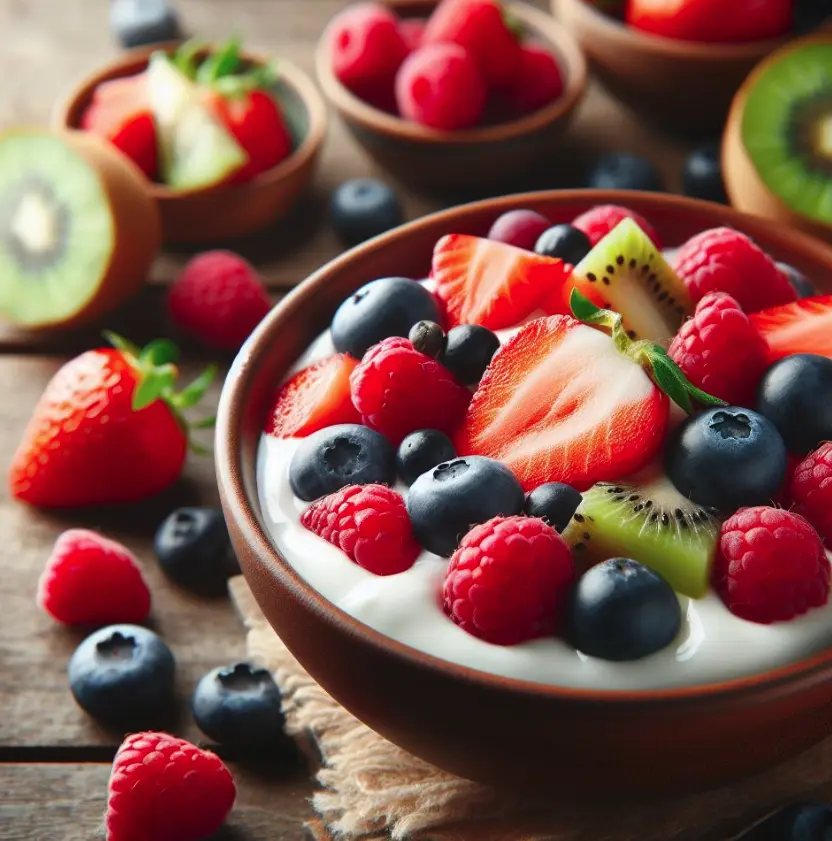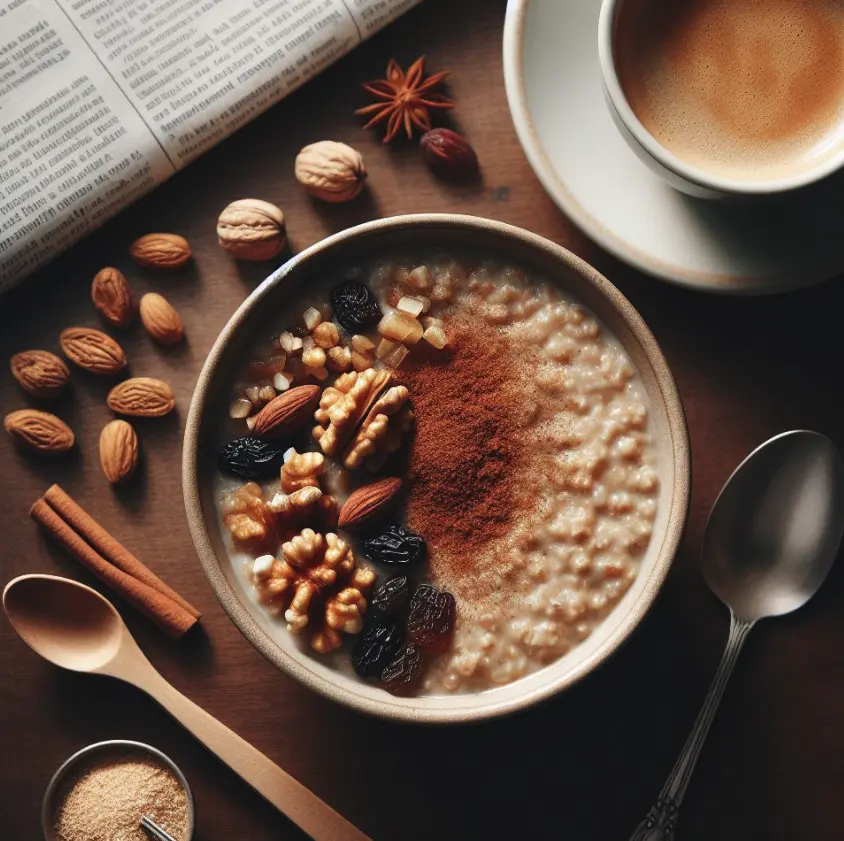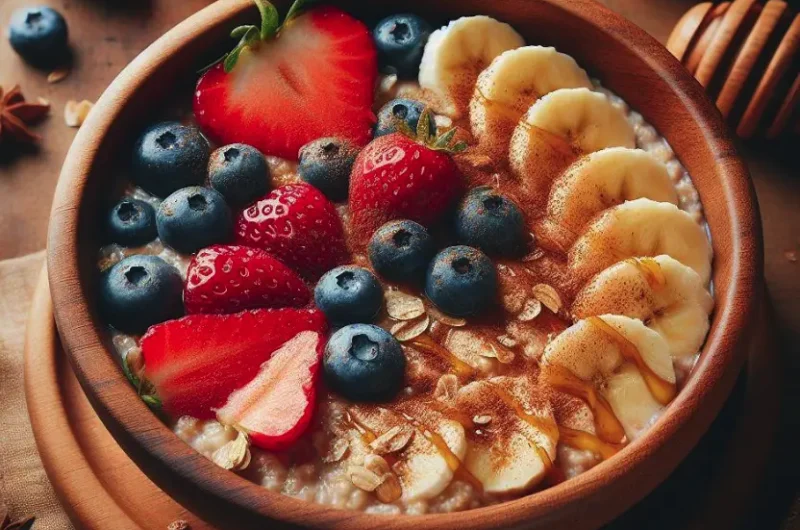The Oats Odyssey: A Grain’s Journey
Hey! We’re talking health today! Oatmeal, a beloved breakfast staple across the United States, has a rich history of nourishing our mornings with its warm, comforting embrace. But beyond its delightful texture and versatility, there’s a question buzzing in the health-conscious corners: is oatmeal high in oxalates?
Before we delve into that, let’s set the stage by understanding this breakfast superstar and why the word “oxalate” is even in the same sentence.
Oxalates, or to be more specific, oxalic acid, is a naturally occurring compound found in several foods. From leafy greens to certain fruits and, yes, even our trusty oatmeal.
The concern around oxalates primarily stems from their potential to form calcium oxalate kidney stones, the most common type of kidney stones. If your body doesn’t efficiently eliminate waste products, these stones can form when oxalates bind with calcium in the urinary tract.
But before we label anything as a villain, let’s remember that many high-oxalate foods are otherwise jam-packed with beneficial nutrients.
It’s all about finding a balanced diet and understanding how much oxalate is in your bowl. For those with a history of kidney stones or specific medical conditions, this becomes particularly relevant.
Oxalates Unrolled: The What and Why
At the heart of our query lies the elusive oxalate. But what exactly is it? Oxalate, or oxalic acid, is a compound found in various foods, and while it sounds menacing, in moderate amounts, it’s completely harmless. However, for those with certain health problems, especially a history of kidney stones, monitoring oxalate intake becomes crucial.

Now, why the fuss about oxalates?
Well, when consumed in large amounts, oxalates can lead to the formation of calcium oxalate stones in the kidneys. This happens when oxalates bind with calcium in the body.
And here’s a fun (or not-so-fun) fact: calcium oxalate stones are the most common type of kidney stones in the United States. Foods notorious for high oxalate content include spinach, beetroot, and certain nuts.
So, while these foods are undeniably healthy, they might not be the best choice for everyone, especially those at a higher risk of kidney issues.

But it’s not all doom and gloom! A low-oxalate diet doesn’t mean bidding farewell to all your favorite foods. It’s about making informed choices and seeking medical advice when needed. And this brings us back to our main question: is oatmeal high in oxalates, and where does it fit in a low-oxalate diet?
Grain Gossip: Oatmeal and Oxalate Levels
Okay, let’s address the elephant (or should we say, the oatmeal bowl?) in the room: is oatmeal high in oxalates? Drumroll, please… Oatmeal does contain oxalates, but its levels can vary.
When compared to certain notorious high-oxalate foods, oatmeal might seem like a moderate oxalate food. But when pitted against other whole grains, its oxalate content can be on the higher side.
Now, when we say “oatmeal,” it’s not a one-size-fits-all scenario. The type of oats, whether steel-cut oats, quick oats, or instant oats, can influence the oxalate content. Recent research suggests that processing can reduce oxalate levels to some extent.
For instance, instant oats might have slightly lower oxalate levels than steel-cut oats. But remember, it’s always essential to have reliable data at hand, so always refer to a list of foods with their oxalate content or consult healthcare professionals when in doubt.
Lastly, it’s crucial to look at the bigger picture when asked, is oatmeal high in oxalates. Oatmeal, despite its oxalate content, is a powerhouse of nutrients and offers numerous health benefits.
For someone without a history of kidney stones or specific medical conditions, oatmeal is a fantastic and healthy choice. But for those on a strict low-oxalate diet, it’s essential to monitor the intake of oxalates and perhaps alternate with low-oxalate grains.
The Oats Spectrum: From Steel-Cut to Instant
Oats come in various avatars, each with its unique taste, texture, and, yes, oxalate content. Steel-cut oats, the least processed of the bunch, have a chewy texture and are often deemed the healthiest option. However, in the context of our current discussion, they might have slightly higher levels of oxalates compared to their more processed counterparts.
On the flip side, we have instant oats. They’re quick, convenient, and a go-to for many on busy mornings. And here’s some good news for instant oat lovers: these oats, due to their processing, might contain somewhat lower oxalate levels.
However, it’s essential to remember that the difference might not be monumental, and for someone strictly monitoring their oxalate intake, it’s essential to have the precise numbers.
In the middle of the spectrum lie rolled oats, which are essentially steel-cut oats that have been steamed and rolled. Their oxalate content sits somewhere between steel-cut and instant oats.
When choosing oats, it’s essential to look beyond just the oxalate content. Each type offers different health benefits, and depending on your dietary needs and medical conditions, one might be a better fit than the others.
Myths and Muesli: Debunking Oats & Oxalate Myths
Time to debunk some myths that address the question, is oatmeal high in oxalates! They’re like breadcrumbs, leading us down fascinating, if not always accurate, paths. Let’s explore some of the common misconceptions about oatmeal and oxalates, and see if we can separate fact from fiction.
Myth 1: Oatmeal is one of the high-oxalate foods. Contrary to popular belief, oatmeal doesn’t top the list of high oxalate foods. While it does contain some oxalate, it’s nowhere near the levels found in some leafy greens or certain nuts. If you’re on a low-oxalate diet, you’d be more concerned about a cup of raw spinach than a bowl of quick oats. However, moderation is key, as with most things in a balanced diet.
Myth 2: Cooking oatmeal reduces its oxalate content significantly. Sorry, folks! While cooking spinach can reduce its oxalate content, the same doesn’t hold true for oatmeal. The oxalic acid content remains fairly stable, whether you’re whipping up instant oats or soaking steel-cut oats overnight. But don’t let this deter you; remember, oatmeal in moderation can still fit into a low oxalate diet.
Myth 3: Adding citrus fruits or vitamin C to oatmeal increases oxalate levels. A sprinkle of orange juice or a dash of maple syrup might elevate the taste, but it doesn’t significantly spike the oxalate levels in your oatmeal.

However, excessive vitamin C intake from supplements might increase the risk of kidney stones in some individuals. Always consult with healthcare professionals before making dietary modifications, especially if you have a history of kidney stones.
Dishing on Diet: Incorporating Oats Safely
Now, you might be thinking, “How do I safely enjoy my oatmeal without overdoing it on the oxalate front?” Don’t worry! Here are some tips and tricks to incorporate oats without compromising on a low-oxalate diet.
Safety Tip 1: Diversify Your Breakfast Options. While oatmeal is a nutritious choice, diversifying your breakfast can help manage your oxalate intake. Consider rotating oatmeal with other whole grains like quinoa or barley. Pair it with low oxalate vegetables or fresh fruit for added flavor and nutrition. Remember, variety is not just the spice of life but also the key to a healthy diet.
Safety Tip 2: Mind Your Toppings. Choose toppings that complement a low-oxalate diet. Greek yogurt, sunflower seeds, flax seeds, and coconut milk are excellent choices. Steer clear of high oxalate foods like peanut butter or certain nuts. And if you’re craving a sweet touch, opt for maple syrup over chocolate chips.
Safety Tip 3: Consult and Consume. If you have medical conditions like chronic kidney disease or a history of calcium oxalate kidney stones, it’s essential to consult with a healthcare provider. They can offer guidance on the mg of oxalate suitable for your diet and suggest beneficial nutrients to pair with your meals.
The Bigger Breakfast Picture: Beyond Oatmeal
While oatmeal is the star of our show, it’s essential to look at the broader breakfast landscape, especially if you’re watching your oxalate intake. So, let’s take a peek beyond the oat-filled bowl and see what other options await.
Breakfast Spotlight 1: Eggs and Olive Oil. Eggs are a good option for those looking to limit oxalate intake, and when cooked with olive oil, they’re both a tasty and healthy choice. Whether you prefer them scrambled, poached, or sunny side up, eggs can be a cornerstone of a low-oxalate diet.
Breakfast Spotlight 2: Dairy Delights. Dairy products, especially calcium-rich foods like Greek yogurt or milk, can help reduce the absorption of oxalate from the digestive tract. Pair them with low oxalate fruits for a delightful morning smoothie. Remember, though, if you’re lactose intolerant, options like soy milk or lactose-free products can come to the rescue.

Breakfast Spotlight 3: Air Fryer Wonders. If you haven’t jumped on the air fryer bandwagon yet, now’s the time! It’s an effective way to whip up a low-oxalate breakfast. Think outside the cereal box—air-fried navy beans with a sprinkle of herbs or pumpkin seeds toasted to perfection can be both hearty and oxalate-friendly.
Closing Crumbs: The Takeaway Toast
As we wrap up our oat-filled exploration, there are a few crumbs of wisdom worth toasting to. Oatmeal, with all its health benefits, can find a place in most diet plans, even if you’re monitoring your oxalate intake.
Closing Crumb 1: Balance Over Banishment. It’s not about banishing oatmeal but about balancing your intake with other low-oxalate food options. Remember, a diet diverse in nutritious foods is often the best choice for overall health.
Closing Crumb 2: Knowledge is Power. Stay informed. Whether it’s recent research from the National Kidney Foundation or reliable data from healthcare professionals, knowledge can guide your dietary choices and reduce the risk of health problems.
Closing Crumb 3: Enjoy the Journey. Dietary journeys are as much about enjoyment as they are about health. So, whether you’re savoring steel-cut oats drizzled with coconut milk or toasting to low oxalate levels with a glass of orange juice, relish the flavors and the journey towards a healthier you.
FAQs
How Do You Remove Oxalates from Oatmeal?
- Boil & Drain: Cook your oatmeal in plenty of water and drain it after cooking. This can help reduce oxalate content as some oxalates are water-soluble.
- Pair with Calcium: Eating oatmeal with calcium-rich foods (like milk) may help. Calcium binds with oxalates, potentially reducing their absorption.
- Fermentation: Consider using fermented oats. The fermentation process might break down some of the oxalates.
Is Oatmeal OK for Kidney Stones?
- Moderation Matters: Oatmeal contains moderate levels of oxalates, so it’s about balance. If you have a history of kidney stones, consult with a healthcare provider.
- Hydration is Key: Drinking plenty of water when eating oatmeal helps to flush out potential oxalates and reduce stone risk.
- Dietary Diversity: Include low-oxalate foods in your diet for a well-rounded approach.
What Grains are Lowest in Oxalates?
- Rice: White and brown rice are typically low in oxalates.
- Quinoa: A nutritious alternative with lower oxalate levels.
- Corn: Corn flour and cornmeal are good low-oxalate options.
What are the Worst Foods for Oxalates?
- Spinach: Surprisingly high in oxalates, so consume in moderation.
- Beets: Both roots and leaves contain significant oxalates.
- Nuts: Especially almonds and peanuts are high in oxalates.
What Flushes Out Oxalates?
- Water: Staying well-hydrated is the simplest way to flush out oxalates.
- Calcium-Rich Foods: They can bind to oxalates in the gut, reducing absorption.
- Balanced Diet: Ensure a varied diet to avoid excessive oxalate intake.
Navigating a low-oxalate diet doesn’t mean compromising on flavor or nutrition. In fact, with the right ingredients, you can create dishes that are both delectable and diet-friendly.
Our Berry Bliss Oatmeal Bowl is a testament to this balance. Oats are a wholesome grain that, when paired with low-oxalate fruits and seeds, provide a nutrient-rich meal without overloading on oxalates.
The inclusion of coconut milk adds creaminess without the oxalate content of regular dairy, and the chosen berries offer a burst of flavor with minimal oxalates. Dive into this recipe to enjoy a meal that’s as kind to your taste buds as it is to your dietary needs!
For great oatmeal combinations, check out this chart:
| Flavoring Category | Examples | Notes |
|---|---|---|
| Fruits | Bananas, Berries, Apples | Fresh or dried for natural sweetness |
| Nuts & Seeds | Almonds, Chia Seeds, Walnuts | Adds crunch and nutritional value |
| Sweeteners | Honey, Maple Syrup, Agave | Natural sweeteners for a flavor boost |
| Spices | Cinnamon, Nutmeg, Ginger | Spice it up for extra zing |
| Dairy & Alternatives | Milk, Almond Milk, Yogurt | Creaminess and extra flavor |
| Superfoods | Acai, Goji Berries, Flaxseed | For a healthy, nutrient-packed bowl |
| Protein Boosters | Peanut Butter, Protein Powder | Ideal for post-workout meals |
| Fun Toppings | Chocolate Chips, Coconut Flakes | For a delightful twist on the classic |
Here’s a delicious and balanced low-oxalate recipe that includes oatmeal. Perfect for breakfast or a nourishing snack:
🍓 Berry Bliss Oatmeal Bowl 🍓
Course: BreakfastCuisine: AmericanDifficulty: Easy2
servings5
minutes20
minutesThis recipe is not only a tasty treat but also aligns well with a low oxalate diet. It’s a delightful way to start your day or recharge during a busy afternoon.
Ingredients
1 cup of quick oats or steel-cut oats (depending on your preference)
2 cups of water or coconut milk (a low oxalate alternative to regular milk)
1/4 cup fresh blueberries (low in oxalates compared to other berries)
1/4 cup fresh strawberries, sliced
2 tbsp sunflower seeds
1 tbsp flax seeds
1 tbsp maple syrup or honey (for a touch of sweetness)
A pinch of salt
1/2 tsp vanilla extract (optional)
Directions
- Cook the Oats: In a medium saucepan, bring the water or coconut milk to a boil. Add a pinch of salt and then stir in the oats. Reduce the heat to low and simmer, stirring occasionally, until the oats are soft and have absorbed most of the liquid. This will take about 5 minutes for quick oats and 20-30 minutes for steel-cut oats.
- Add Flavor: Once the oats are cooked, stir in the maple syrup or honey and vanilla extract if using.
- Serve it Up: Divide the cooked oatmeal between two bowls. Top each bowl with an equal amount of blueberries, strawberries, sunflower seeds, and flax seeds.
- Enjoy! Dive into your Berry Bliss Oatmeal Bowl and savor every bite!
Notes
- Oats are a great source of fiber and essential nutrients, making them an excellent choice for a healthy diet.
- Blueberries and strawberries offer a burst of flavor without adding too many oxalates.
- Sunflower and flax seeds provide healthy fats and a delightful crunch.
- Coconut milk adds creaminess to the oatmeal while keeping it low in oxalates.
Craving more delicious recipes? Try these: Classic Banh Beo

